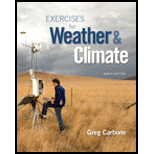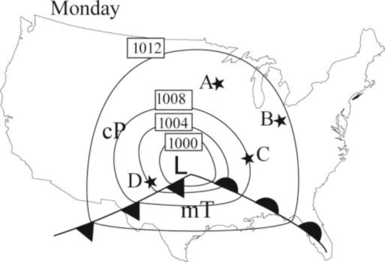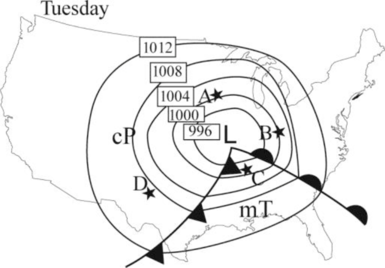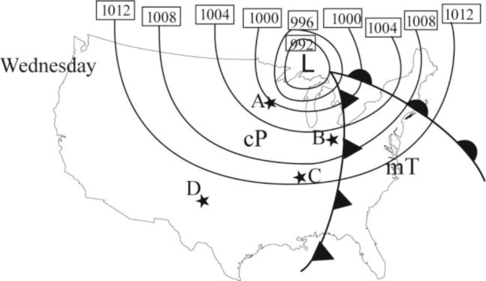
Labelling the air masses in the maps in Figure 10-2.
Answer to Problem 1E
The following picture shows the air mass on Monday.

The following picture shows the air mass on Tuesday.

The following picture shows the air mass on Wednesday.

Explanation of Solution
According to Norwegian polar front theory, the mid latitude cyclones are occurring in northern hemisphere along a stationary front, when two different temperature of air masses flowing in opposite direction in the same front.
A separating barrier is formed between these two air masses and wave like a surface flow is developed, such as warm air conveyer belt.
When cold air overtakes the warm air and it is separated from the center of the low-pressure occluded front is formed and pave the way for steepest pressure gradient.
The surface flow forms an isobar with the low pressure at the center of the wave and at final stage, the flow is inward and counterclockwise. Finally, air mass will start to weaken, and then storm will start to disintegrate.
Always mid latitude cyclones require two different extreme temperature air masses. In summer, the different in temperature is less compared to that of in winter and spring. Hence, mid latitude cyclones are occurring in less over United States in hot season compared to that of in winter and spring.
Always moisture characteristics are represented by small letter and temperature characteristics are represented as capital letter. The following are the examples of different air mass representation.
- maritime equatorial – mE
- maritime tropical –mT
- maritime polar –mP
- continental tropical –cT
- continental polar – cP
- continental arctic–cA
Below the warm front, air mass categorized as mT and it is warm. This air mass contains moisture in general. Above the cold front, the air mass categorized as cP and it is generally cold and dry.
Want to see more full solutions like this?
Chapter 10 Solutions
Exercises for Weather & Climate Plus Mastering Meteorology with eText -- Access Card Package (9th Edition)
 Applications and Investigations in Earth Science ...Earth ScienceISBN:9780134746241Author:Edward J. Tarbuck, Frederick K. Lutgens, Dennis G. TasaPublisher:PEARSON
Applications and Investigations in Earth Science ...Earth ScienceISBN:9780134746241Author:Edward J. Tarbuck, Frederick K. Lutgens, Dennis G. TasaPublisher:PEARSON Exercises for Weather & Climate (9th Edition)Earth ScienceISBN:9780134041360Author:Greg CarbonePublisher:PEARSON
Exercises for Weather & Climate (9th Edition)Earth ScienceISBN:9780134041360Author:Greg CarbonePublisher:PEARSON Environmental ScienceEarth ScienceISBN:9781260153125Author:William P Cunningham Prof., Mary Ann Cunningham ProfessorPublisher:McGraw-Hill Education
Environmental ScienceEarth ScienceISBN:9781260153125Author:William P Cunningham Prof., Mary Ann Cunningham ProfessorPublisher:McGraw-Hill Education Earth Science (15th Edition)Earth ScienceISBN:9780134543536Author:Edward J. Tarbuck, Frederick K. Lutgens, Dennis G. TasaPublisher:PEARSON
Earth Science (15th Edition)Earth ScienceISBN:9780134543536Author:Edward J. Tarbuck, Frederick K. Lutgens, Dennis G. TasaPublisher:PEARSON Environmental Science (MindTap Course List)Earth ScienceISBN:9781337569613Author:G. Tyler Miller, Scott SpoolmanPublisher:Cengage Learning
Environmental Science (MindTap Course List)Earth ScienceISBN:9781337569613Author:G. Tyler Miller, Scott SpoolmanPublisher:Cengage Learning Physical GeologyEarth ScienceISBN:9781259916823Author:Plummer, Charles C., CARLSON, Diane H., Hammersley, LisaPublisher:Mcgraw-hill Education,
Physical GeologyEarth ScienceISBN:9781259916823Author:Plummer, Charles C., CARLSON, Diane H., Hammersley, LisaPublisher:Mcgraw-hill Education,





